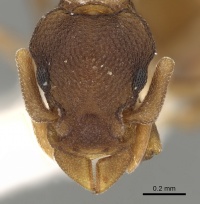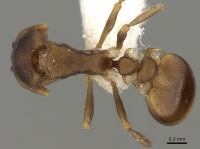Colobostruma alinodis
| Colobostruma alinodis | |
|---|---|

| |
| Scientific classification | |
| Kingdom: | Animalia |
| Phylum: | Arthropoda |
| Class: | Insecta |
| Order: | Hymenoptera |
| Family: | Formicidae |
| Subfamily: | Myrmicinae |
| Tribe: | Attini |
| Genus: | Colobostruma |
| Species: | C. alinodis |
| Binomial name | |
| Colobostruma alinodis (Forel, 1913) | |
This widespread species can be abundant in some areas within its range. It can be found nesting under rocks in a variety of habitats, from dry sclerophyll to rainforest.
Identification
The presence of a 4-segmented antenna with an elongate second funicular segment will separate this taxon from others in the alinodis-group (Shattuck 2000).
Keys including this Species
Distribution
Known from Queensland, New South Wales, Victoria and Tasmania.
Latitudinal Distribution Pattern
Latitudinal Range: -15.05000019° to -43.45°.
| North Temperate |
North Subtropical |
Tropical | South Subtropical |
South Temperate |
- Source: AntMaps
Distribution based on Regional Taxon Lists
Australasian Region: Australia (type locality).
Distribution based on AntMaps
Distribution based on AntWeb specimens
Check data from AntWeb
Countries Occupied
| Number of countries occupied by this species based on AntWiki Regional Taxon Lists. In general, fewer countries occupied indicates a narrower range, while more countries indicates a more widespread species. |

|
Estimated Abundance
| Relative abundance based on number of AntMaps records per species (this species within the purple bar). Fewer records (to the left) indicates a less abundant/encountered species while more records (to the right) indicates more abundant/encountered species. |

|
Biology
Brown (1954) - Colobostruma alinodis has been taken in moist or wet sclerophyll forest, often near or in clearings. On three occasions I took this ant, twice in the Dandenongs and once on Tamborine Mountain, southeastern Queensland, in each case under a stone also covering a flourishing nest of one of the common and dominant Rhytidoponera ("Chalcoponera") species, commonly infested with unpigmented entomobryid collembolans. I have not myself seen, nor do I know of other records definitely stating, that this species or its close relatives show any preference for nest sites near or in Rhytidoponera nests except as indicated by my three collections.
Castes
Nomenclature
The following information is derived from Barry Bolton's Online Catalogue of the Ants of the World.
- alinodis. Epopostruma alinodis Forel, 1913g: 179, pl. 2, figs. 1, 2 (w.q.) AUSTRALIA (Tasmania).
- Type-material: syntype workers (number not stated), 1 syntype queen.
- Type-locality: Australia: Tasmania, Railton (A.M. Lea).
- Type-depositories: ANIC, MHNG, MCZC.
- [Misspelled as alata by Wheeler, G.C. & Wheeler, J. 1973c: 211.]
- Crozier, 1968b: 88 (k.); Wheeler, G.C. & Wheeler, J. 1973c: 211 (l.).
- Combination in Clarkistruma: Brown, 1948e: 124;
- combination in Colobostruma: Brown & Wilson, 1959b: 281.
- Status as species: Emery, 1924d: 330; Brown, 1948e: 124; Brown, 1954b: 466; Brown & Wilson, 1959: 281; Taylor & Brown, 1985: 59; Taylor, 1987a: 22; Bolton, 1995b: 146; Shattuck, in Bolton, 2000: 34 (redescription).
- Distribution: Australia.
Type Material
- Syntype, 1 worker, Railton, Tasmania, Australia, <collector unknown>, ANIC32-015700, Australian National Insect Collection.
- Syntype, 7 workers, Railton, Tasmania, Australia, Museum of Comparative Zoology.
- Syntype, worker(s), Railton, Tasmania, Australia, Musee d'Histoire Naturelle Genève.
- Syntype, 6 workers, Railton, Tasmania, Australia, South Australian Museum.
Unless otherwise noted the text for the remainder of this section is reported from the publication that includes the original description.
Description
Worker
Shattuck (2000) - WORKER. TL 2.2 - 3.4, HL 0.52 - 0.80, HW 0.48 - 0.66, CI 81 - 92, ML 0.13 - 0.17, MI 20 - 25, SL 0.24 - 0.47, SI 50 - 70, PW 0.32 - 0.43, AL 0.59 - 0.91 (7 measured). Anterior region of head rounding gradually from the dorsal to lateral surfaces, not phragmotic. In full-face view ridge immediately in front of eye weakly defined, concave. Frontal lobes and lateral margins of clypeus smooth relative to surrounding surface of the head. Mandibles broadly triangular. Hairs on dorsum of head scattered, thin. Posterior margin of head uniformly concave. Antenna with 4 or 5 segments, when 5-segmented the third funicular segment from the base is much shorter than the second segment; the second funicular segment long, more than twice the length of the first segment. Scape strongly elbowed and without a subbasal lobe. In dorsal view the widest point of the pronotum is at the humeral angles. Propodeum high, its posterior face greater in height than the petiolar node and with broad, thin lamellae; in profile the dorsum of the alitrunk essentially flat. Lateral postpetiole drawn outwards into thin flange-like wings, the wings with translucent windows along both their anterior and posterior margins, the windows separated by a narrow band of thickened integument and the anterior windows smaller than the posterior windows. First gastral tergite smooth, superimposed with low, closely spaced carinae on the anterolateral corners. Body colour yellow-brown to dark brown, dorsum of head and alitrunk often slightly darker, antennae and legs slightly lighter, gaster often with a slightly darker, broad medial band.
Karyotype
- See additional details at the Ant Chromosome Database.
 Explore: Show all Karyotype data or Search these data. See also a list of all data tables or learn how data is managed.
Explore: Show all Karyotype data or Search these data. See also a list of all data tables or learn how data is managed.
- n = 11, 2n = 22, karyotype = 22M (Australia) (Crozier, 1968d).
References
- Bolton, B. 2000. The ant tribe Dacetini. Mem. Am. Entomol. Inst. 65: 1-1028 (page 34, see also)
- Brown, W. L., Jr. 1948e. A preliminary generic revision of the higher Dacetini (Hymenoptera: Formicidae). Trans. Am. Entomol. Soc. 74: 101-129 (page 124, Combination in Clarkistruma)
- Brown, W. L., Jr. 1954b. A preliminary report on dacetine ant studies in Australia. Ann. Entomol. Soc. Am. 46: 465-471.
- Brown, W. L., Jr.; Wilson, E. O. 1959b. The evolution of the dacetine ants. Q. Rev. Biol. 34: 278-294 (page 281, Combination in Colobostruma)
- Crozier, R. H. 1968c. The chromosomes of three Australian dacetine ant species (Hymenoptera: Formicidae). Psyche (Camb.) 75: 87-90 (page 88, karyotype described)
- Forel, A. 1913h. Fourmis de Tasmanie et d'Australie récoltées par MM. Lae, Froggatt etc. Bull. Soc. Vaudoise Sci. Nat. 49: 173-195 (page 179, pl. 2, figs. 1, 2 worker, queen described)
- Jacintho, G.de F., Vieira, E.M.de A., Teixeira, G.A., Lopes, D.M., Serrão, J.E. 2024. First karyotype description for Acanthognathus rudis Brown & Kempf, 1969 (Formicidae: Myrmicinae) with notes on its natural history. Sociobiology 71(3), e10778 (doi:10.13102/sociobiology.v71i3.10778).
- Shattuck, S. O. 2000. Genus Colobostruma. Genus Mesostruma. Genus Epopostruma. Pp. 31-67 in: Bolton, B. The ant tribe Dacetini. Mem. Am. Entomol. Inst. 65: 1-1028
- Wheeler, G. C.; Wheeler, J. 1973c. The ant larvae of the tribes Basicerotini and Dacetini: second supplement (Hymenoptera: Formicidae: Myrmicinae). Pan-Pac. Entomol. 49: 207-214 (page 211, larva described)
References based on Global Ant Biodiversity Informatics
- Bolton, B. 2000. The Ant Tribe Dacetini. Memoirs of the American Entomological Institute 65
- CSIRO Collection
- Forel A. 1913. Fourmis de Tasmanie et d'Australie récoltées par MM. Lae, Froggatt etc. Bull. Soc. Vaudoise Sci. Nat. 49: 173-195
- Taylor R. W. 1987. A checklist of the ants of Australia, New Caledonia and New Zealand (Hymenoptera: Formicidae). CSIRO (Commonwealth Scientific and Industrial Research Organization) Division of Entomology Report 41: 1-92.
- Taylor R. W., and D. R. Brown. 1985. Formicoidea. Zoological Catalogue of Australia 2: 1-149.

